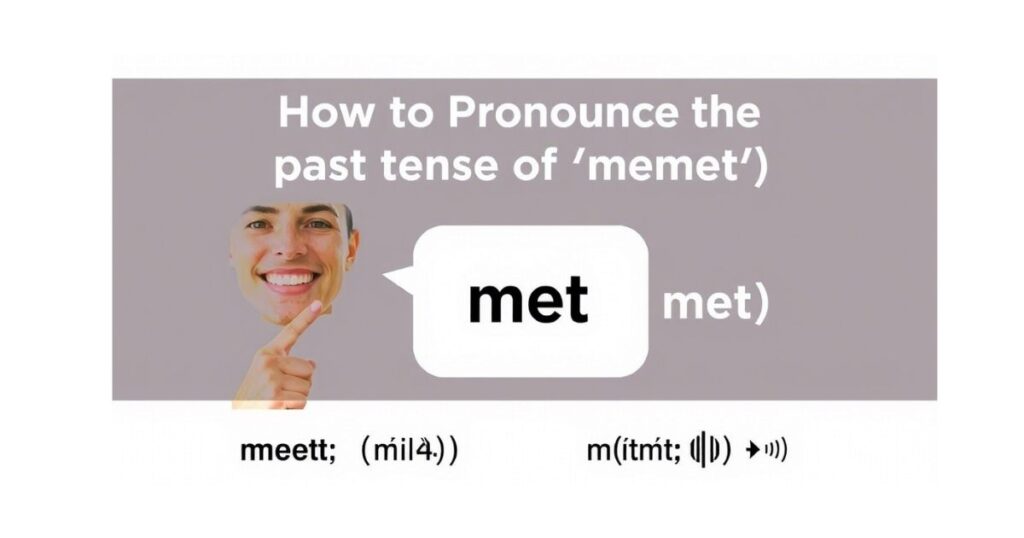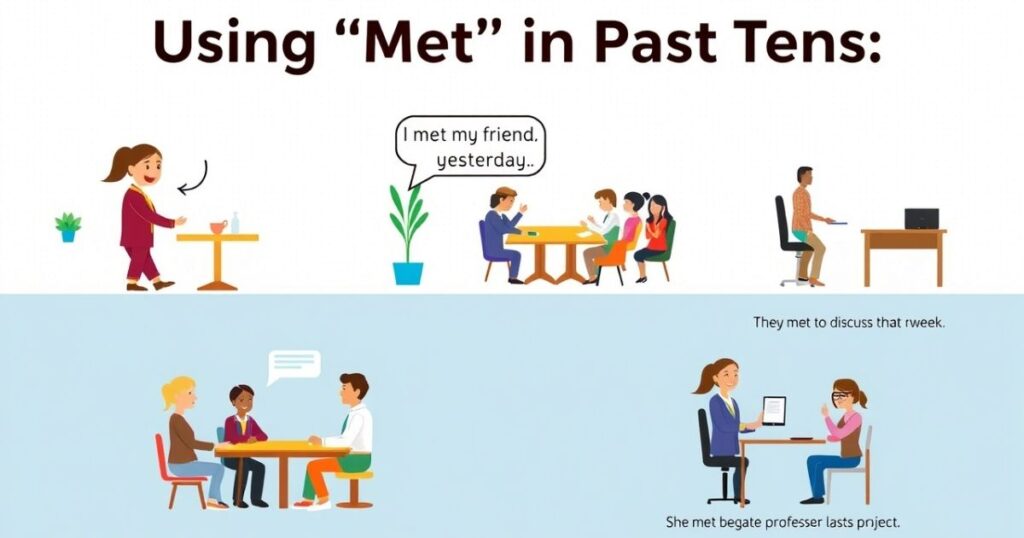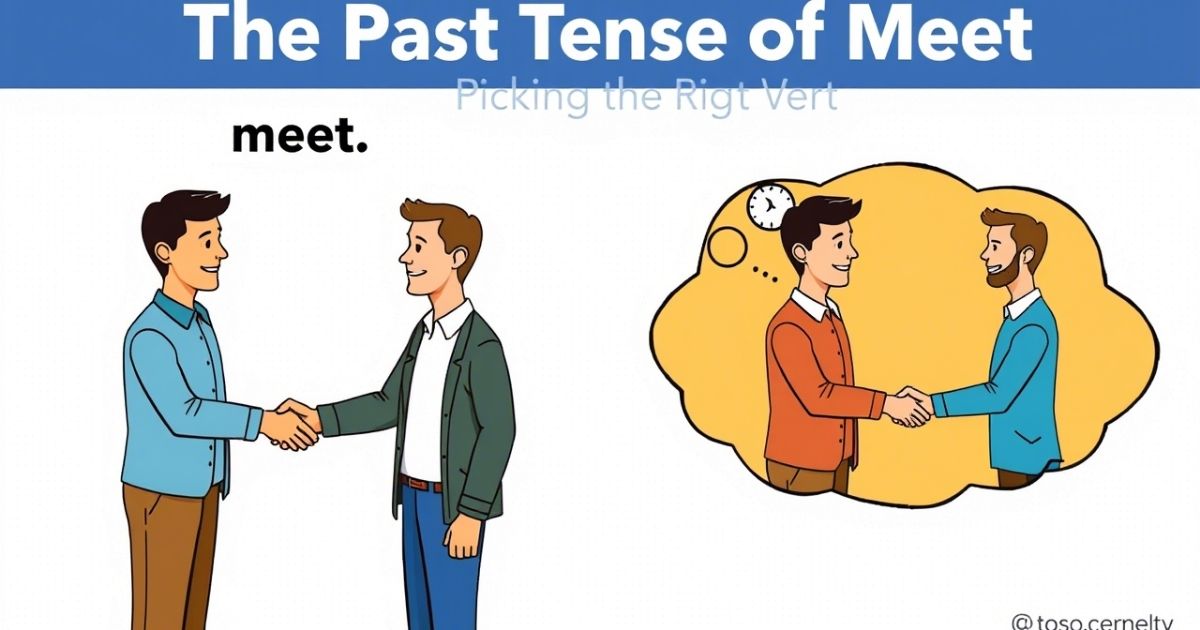Understanding The Past Tense of Meet is crucial for mastering English grammar. Many learners confuse the verb “meet” and its past tense form, “met.” While both are essential for everyday conversations, it’s important to know when to use each one. The Past Tense of Meet plays a key role in describing actions that happened in the past.
Whether you’re talking about meeting someone for the first time or recalling a past event, knowing the correct tense is vital. By learning The Past Tense of Meet, you will avoid common mistakes and sound more natural in your speech. This article will guide you through the correct usage of “meet” and “met,” giving you the confidence to use these forms correctly in various contexts.
How to Pronounce the Past Tense of “Meet” i.e “Met”

The verb meet is an irregular verb, which means it doesn’t follow the typical pattern of adding -ed to form the past tense. The past tense of meet is met. When you pronounce these words, you’ll notice they sound quite similar, with just a slight change in vowel sound. Meet has a long ee sound, while met uses a short e sound, like in the word set.
Both words, though different in pronunciation, follow the same rhythm and pattern in most accents. Some people might confuse the two, especially when spoken quickly, but focusing on the different vowel sounds will help you master this pronunciation. It’s important to practice, especially in conversation, to avoid mistakes when using met in the past tense.
Read this Also: What’s the Past Tense of Fall Down? Explained with Examples
What does the Word “Meet” Mean
The verb meet generally means to encounter someone or something, often for the first time. It is used in various contexts, whether you’re talking about meeting a friend, meeting new people at a convention, or even meeting expectations at work. In addition, meet can also refer to joining a group or coming together for a specific purpose, such as meeting at a cafe with friends or meeting to discuss future events.
When meat is used in the present tense, it’s often about a recurring event. For instance, you might say, “I meet my colleagues every Monday for a team meeting,” or “We meet regularly at the park to play.” As we dive deeper into this verb’s conjugation, you’ll see how it changes in the past tense to meet for events that happened before.
The Simple Verb Tense Table
Verb tenses are essential to understand because they help us talk about when actions happen. For example, the verb meets changes based on when the action takes place. The base form, meet, is used in the present tense, future tense, and the infinitive form, such as “I meet new people every day” or “I plan to meet my friends tomorrow.”
| Tense | Positive | Negative | Question |
| Present | I met my friend. | I didn’t meet my friend. | Do I meet my friend? |
| Past | I met my friend. | I didn’t meet my friend. | Did I meet my friend? |
| Future | I will meet my friend. | I won’t meet my friend. | Will I meet my friend? |
In the past tense, however, the base form meet becomes met. This is the irregular form of the verb, and it doesn’t follow the regular pattern where we simply add -ed to create the past tense. For example, “Yesterday, I met my brother at the store.” The past participle of meet is also met, which means you would use it in perfect tenses, like “I have met everyone on the team” or “They had met all their goals before the deadline.”
Origin of the Word “Meet”

The word meet comes from Old English. It came from the verb mētan, which meant to encounter, come together, or find. Over time, the verb changed. Its meaning grew to include both real and idea-based meetings. The change from mētan to meet happened as English developed. Latin, Germanic, and French also influenced it.
Meet is an irregular verb. It belongs to a group with words like let, set, and bet. These verbs do not follow regular patterns. That’s why it’s important to know meet is special. It has kept the meaning of “coming together” for many years. It shows both real meetings and shared ideas.
Usage of “Meet” and “Met” in Everyday Conversations
Meet and met are important verbs in English. We use them often in daily speech. For example, you can say, “I meet my friends at the park every weekend.” This shows a regular action.
But if it happened before, you say, “I met my boss yesterday to discuss the project.”
It’s important to know when to use meet or met.
Use meet for habits or future plans.
Use met for things that already happened. By recognizing when and how to use each form, you can avoid common mistakes and ensure your sentences sound natural.
Using “Meet” in Present Tense:
The verb meet in the present tense refers to actions that happen regularly or in the near future. It’s used when talking about events that are happening now, repeated actions, or things that are about to occur. For example, you might say, “I meet with clients every Friday” or “I meet new people at conventions.” It’s a straightforward verb form that expresses routine, scheduled actions or things that are happening at this moment.
Using “Met” in Past Tense:

On the other hand, met is the past tense form of meet, and it’s used to refer to actions that took place at a specific time in the past. You would say, “I met my friend last week at the cafe” to talk about a one-time event that already happened. Met can also be used in the past participle Met is the past tense of meet.
We use it for actions that happened in the past.
For example, “I met my friend last week at the café.”
This shows something that happened once.
Met is also used as a past participle.
You can say, “I have met all of my work goals.”
This means the action is finished.form to describe something that was completed, as in “I have met all of my work goals.”
Synonyms of “Meet” and “Met”
To grow your vocabulary, it’s good to know other words you can use instead of “meet” and “met.” These words can help make your writing or speaking sound more interesting. While not every word fits all the time, many can be used in similar ways.
Synonyms of “Meet” (Present Tense):
- Encounter – “I encounter new people at work every day.”
- Greet – “I greet my friends when I see them.”
- Come across – “I sometimes come across interesting people online.”
- Run into – “I often run into my neighbors at the store.”
- Bump into – “I bump into classmates at the café.”
Synonyms of “Met” (Past Tense):
- Encountered – “I encountered an old teacher at the mall.”
- Greeted – “I greeted my guests with a smile.”
- Came across – “I came across an old photo of us.”
- Ran into – “I ran into an old friend yesterday.”
- Bumped into – “I bumped into my boss at the airport.”
Conclusion
Understanding The Past Tense of Meet is essential for speaking and writing correctly in English. The past tense of meet is met, and it’s important to use it when talking about something that happened in the past. Using met correctly helps you sound more natural and clear in your communication.
When you are unsure whether to use meet or met, remember that meet is used for present or future actions, while met refers to past events. Practicing The Past Tense of Meet will help you avoid mistakes and improve your grammar. With a little practice, you’ll feel confident using these verb forms in your everyday conversations and writing.

Gramcoachpro is your go-to platform for mastering grammar, writing, and communication skills. If you’re a student, teacher, or content creator, we provide easy-to-understand tips, examples, and tools to improve your language — fast and effectively. Our mission is to make better writing simple and accessible for everyone.

